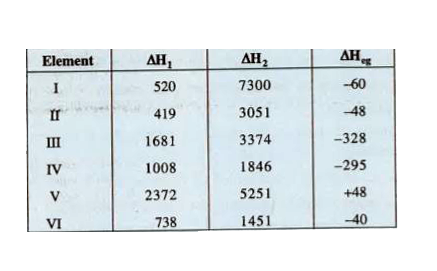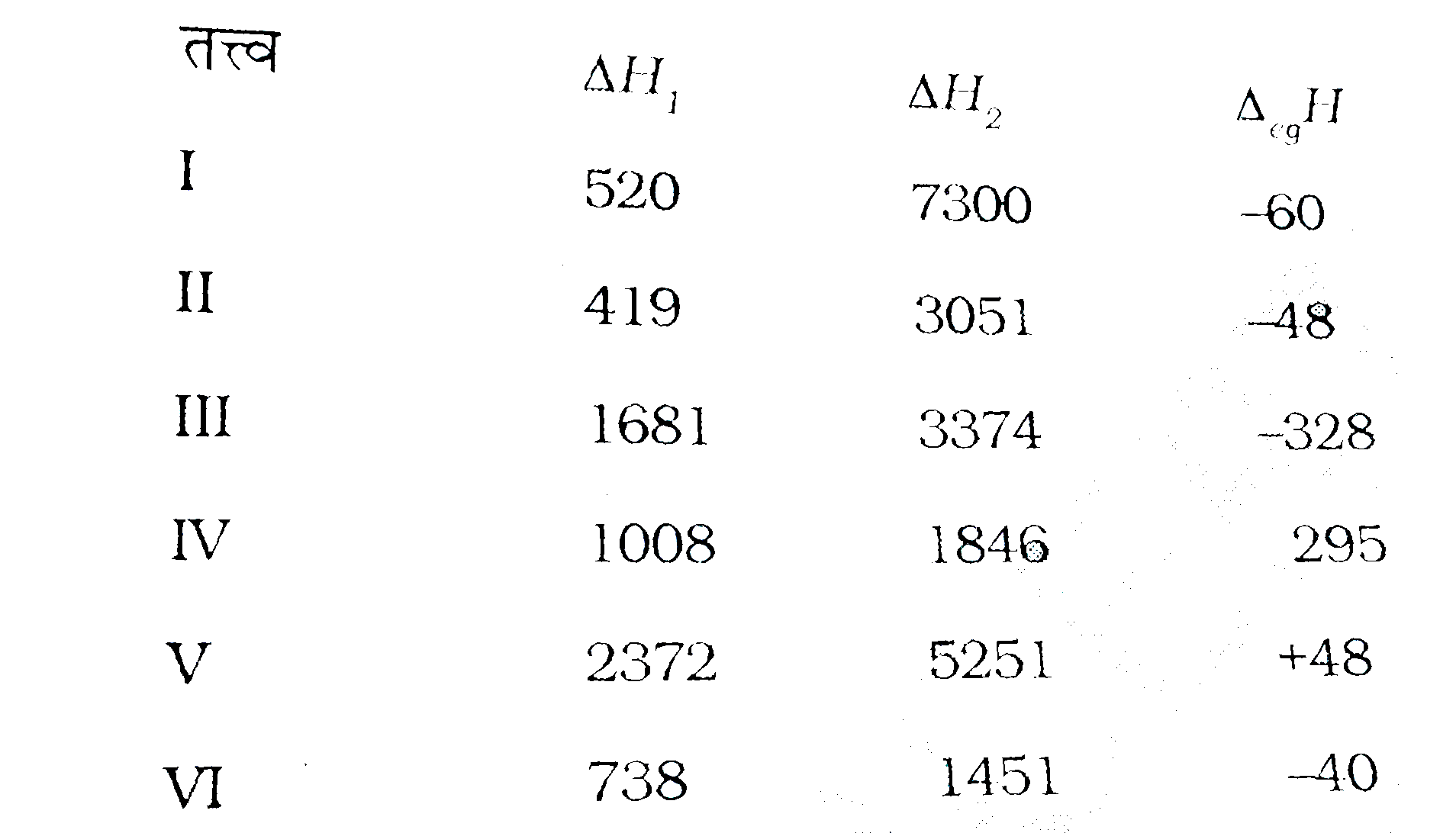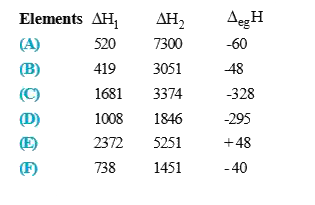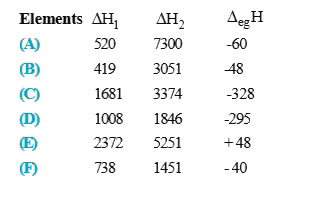The first (D≤taH) and second ionisation enthalipies (ΔH2) in kJmol−1 and the electron gain enthalpy (ΔHg) in kJmol−1 of a few elements are given below:

Which element is likely
a) the least reactive element
c) the most reactive non-metal
b) the most reactive metal
d) the least reactive non-metal
f) the metal which can form a predominantly stable covalent halide of the formula MX.Solution in Telugu
a−V,b−II,c−III,d−IV,e−VIandf−I
Topper's Solved these Questions
- BOOK - AAKASH SERIESCHAPTER - PERIODIC TABLEEXERCISE - DO YOU KNOW54videos
PERIODIC TABLE
- BOOK - AAKASH SERIESCHAPTER - NUCLEAR CHEMISTRY EXERCISE - PRACTICE SHEET - 2 (Integer answer type Questions )8videos
NUCLEAR CHEMISTRY
- BOOK - AAKASH SERIESCHAPTER - POLYMERSEXERCISE - OBJECTIVE EXERCISE - 459videos
POLYMERS
Similar Questions
Which is the lightest element?
10:56View SolutionThe difference between number of α and β particles emitted during the conversion of U23892→Pb20682 is
10:55View Solution(A) Glyptal is a condensation homo polymer.
(R) Glyptal is used to prepare.computer discs.04:10View SolutionThe first (Delta_(i)H_(1)) and second (Delta_(i)H_(2)) ionisation enthalpies ("in" kJ mol^(-1)) and the (Delta_(eg)H^(ө)) electron gain enthalpy ("in" kJ mol^(-1)) of a few elements are given below: {:("Elements",(Delta_(i)H_(1)),(Delta_(i)H_(2)),Delta_(eg)H^(ө)),(I,520,7300,-60),(II,419,3051,-48),(III,1681,3374,-328),(IV,1008,1846,-295),(V,2372,5251,+48),(VI,738,1451,-40):} Which of the above elements is likely to be a. the least reactive element. b. the most reactive metal. c. the most reactive non-metal. d. the least reactive non-metal. e. the metal which can form a stable binary halide of the formula MX (X=halogen). f. the metal which can form a predominantly stable covalent halide of the formula MX(X=halogen).
10:56View Solutionकुछ तत्वों की प्रथम Δ1H1 और द्वितीय Δ1H2 आयनन एन्थैल्पी (KJmol−1 में) और इलेक्ट्रॉन लब्धि एन्थैल्पी (ΔegH) (KJmol−1 में) निम्नलिखित है -

ऊपर दिए गए तत्वों में से कौन-सी
(क) सबसे कम अभिक्रियाशील धातु है ?
(ख) सबसे अधिक अभिक्रियाशील धातु है ?
(ग) सबसे अधिक अभिक्रियाशील अधातु है ?
(घ) सबसे कम अभिक्रियाशील अधातु है ?
(ड़) ऐसी धातु है, जो स्थायी द्विअंगी हैलाइड (binary halide), जिनका सूत्र MX2 (X = हैलोजन) है बनाता है |
(च) ऐसी धातु, जो मुख्यत: MX (X= हैलोजन) वाले स्थायी सहसंयोजी हैलाइड बनाती है |View SolutionThe most reactive non metal
View SolutionThe first (Delta_(i)H_(1)) and the (Delta_(i)H_(2)) ionization enthalpy (in kJ mol^(-1) ) and the (Delta_(eg) H) electron gas enthalpy (in kJ mol^(-1) ) of a few elements are given below : {:("Element",,Delta_(i)H_(1),,Delta_(i)H_(2),,Delta_(eg)H),(I,,520,,7300,,-60),(II,,419,,3051,,-48),(III,,1681,,3374,,-328),(IV,,1008,,1846,,-295),(V,,2372,,5251,,+48),(VI,,738,,1451,,-40):} Which of the above element is likely to be : (a) the least reactive element ( b) the most reactive metal (c ) the most reactive non- metal ( d ) the least reactive non- metal ( e) metal which can form a stable binary halide of the formula MX_(2) ( x= halogen ) ? (f ) the metal which can form predominantly stable covalent halide of the formula MX ( X= halogen ) ?
02:13View SolutionMatch the correct ionisation enthalpies and electron gain enthalpies of the following elements {:(,,"Elements",,,,DeltaH_(1),,DeltaH_(2),,Delta_(eg)H),((i),,"Most reactive non metal",,A.,,419,,3051,,-48),((ii),,"Most reactive metal",,B.,,1681,,3374,,-328),((iii),,"Least reactive element ",,C.,,738,,1451,,-40),((iv),,"Metal forming binary halide " ,,D.,,2372,,5251,,+48):}
02:39View SolutionThe first ionization energy (IE1) and second ionization energy (IE2) of elements A,B and C are given below
ElementABCIE1kJmol−123705221680IE2kJmol−1525072983381
Which one of above elements is the most reactive metal ?03:12View SolutionThe first and second ionization enthalpies and electron gain enthalpy of some elements are as given below: Which of these elements is the most reactive metal?
13:44View SolutionThe first and second ionization enthalpies and electron gain enthalpy of some elements are as given below:

Which of these elements is the most reactive non-metal?08:39View SolutionThe first and second ionization enthalpies and electron gain enthalpy of some elements are as given below:

Which of these elements is the least reactive non-metal?04:59View SolutionThe first (Delta_(i)H_(1)) and second (Delta_(i)H_(2)) ionization enthalpies ("in kJ mol"^(-1)) and the electron gain enthalpy (Delta_(eg)H)("in kJ mol"^(-1)) of the elements I, II, III, IV and V are given below the least reactive non - metal and the most reactive metal of these are respectively
View SolutionThe first ionisation energy (IE_1) and second ionisation energy (IE_2) of elements X, Y and Z are given below. Which one of the above elements is the most reactive metal, the least reactive metal and a noble gas?
04:49View SolutionThe first (ΔiH1) and second (ΔiH2) ionisation enthalpies (inkJmol−1) and the (ΔegHө) electron gain enthalpy (inkJmol−1) of a few elements are given below:
Elements(ΔiH1)(ΔiH2)ΔegHөI5207300−60II4193051−48III16813374−328IV10081846−295V23725251+48VI7381451−40
Which of the above elements is likely to be
a. the least reactive element.
b. the most reactive metal.
c. the most reactive non-metal.
d. the least reactive non-metal.
e. the metal which can form a stable binary halide of the formula MX2 (X=halogen).
f. the metal which can form a predominantly stable covalent halide of the formula MX(X=halogen).04:35View Solution

